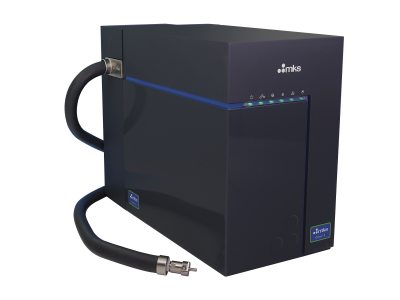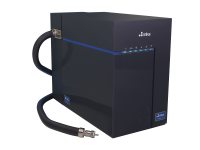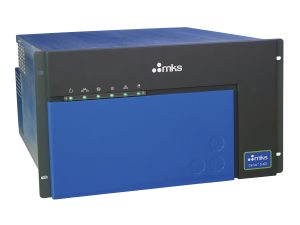Cirrus™ 3 Powerful and Versatile Atmospheric Gas Analyzer
Overview
Building on proven Cirrus Quadrupole Mass Spectrometry technology, the Cirrus 3 combines state-of-the-art performance in compact benchtop and rack-mounted formats. With a heated capillary inlet and fast scan speed (250 points per second), gas compositions can be tracked over wide dynamic range (ppb to percentage levels) more reliably.
- Monitors multiple gas species from trace levels (ppb) to high abundance
- Fast response - 250 data points per second & capillary inlet heated up to 300°C
- Precise and stable user-defined temperature control with enhanced oven and capillary designs
- Detect gases up to 300 amu. High resolution options (1-100HP)
- Recipe-driven Process Eye™ Professional supports gas monitoring and quantitation applications
Products
| Compare | Description | Drawings, CAD & Specs | Availability | Price | |||
|---|---|---|---|---|---|---|---|

|
CIRRUS-3 Atmospheric Gas Analyzer, Quadrupole Mass Spectrometry, Cirrus 3 |
|
Specifications
-
Mass Range1-100 amu; 100HP, 1-200 amu and 1-300 amu options
-
Minimum Detectable ConcentrationGas dependent,
<100 ppb for non-interfering species -
Electron Energy & Emission CurrentOperator variable
-
Operating Temperature5° to 35°C
-
Maximum Operating Conditions20% to 80% RH (non-condensing)
-
Bake Out Temperature180°C
-
Inlet2.0 m long with 0.25 inch Swagelok® end connection, heated to 150°C
-
Gas Consumption20 ml/min
-
Sample Pressure1 bar nominal
-
Pumping SystemHigh compression turbo-molecular pump with internal 4-stage diaphragm backing pump standard
-
Vacuum Hardware60 l/s turbo molecular pump with high conductance analyzer housing, inlet system, automated vacuum controller (RVC) completely interlocked and integrated.
-
Automated Inlet Pressure Controller640 (Baratron® capacitance manometer based) automated inlet pressure controller is available as an option
-
PC RequirementsMicrosoft 32 bit or 64 bit Windows® 7 or 10
-
Interfaces1 x RJ45 Ethernet LAN port required
-
I/O Capability4 analog inputs (-11 to +11 volt, 22 bit)
2 analog outputs (0-10 volt, 12 bit)
16 TTL digital I/O -
Power Requirements100 - 240 VAC, 50 - 60 Hz
-
ComplianceCE
-
DimensionsBenchtop System: 593 mm L x 291 mm W x 470 mm H
Rack-mount System: 577 mm L x 482 mm W x 266 mm (6U) H -
Weight35 kg
Features
Fast and Reproducible Data
Cirrus systems are based on Quadrupole Mass Spectrometry, widely acknowledged as a preferred platform technology for many atmospheric pressure gas analysis applications. The Cirrus 3 system, with its improved temperature control and compact design, provides high levels of performance and robustness in space-efficient and flexible configurations that are ideal for a wide range of analytical applications.
Precision engineered to provide fast and reproducible data, Cirrus 3 can accurately detect and quantify gases and gas mixtures, from one or more sampling locations with a single instrument. Gas composition can be monitored over a wide dynamic range, from percentage levels down to the sub ppm range.
Cirrus 3 is an ideal choice for atmospheric gas analysis whether you work in a research setting or a manufacturing environment. By combining Process Eye Professional software with MKS technical support, Cirrus can be integrated, optimized, and automated to your precise specifications. Ultimately, users across your organization realize greater benefits of the power of quadrupole mass spectrometry.
Quadrupole Analyzer
At the heart of every Cirrus 3 system is a precision-built quadrupole analyzer incorporating a closed ion source, a triple mass filter, and a dual (Faraday and Secondary Electron Multiplier) detector system. This analyzer configuration is selected to optimize sensitivity and longterm performance stability
Heating and Vacuum System
The Cirrus 3 features a number of advancements in design that aid stability and reproducibility of results. The vacuum chamber (with quadrupole analyzer) and inlet interface assembly is housed within a precision engineered stainless steel oven, providing low heat sink characteristics. This offers high temperature uniformity and eliminates potential cold spots that could otherwise cause undesirable sample condensation and variance in analyses. The oven design enables user-defined temperature control of the oven and capillary, allowing for finer analytical control.
The quadrupole analyzer itself is contained within a stainless steel vacuum chamber which is pumped by a high compression turbo molecular/diaphragm pump combination. The vacuum system is backed by an internal 4-stage diaphragm pump to maintain the integrity of the compact design. The entire Cirrus 3 vacuum chamber can also be baked to reduce residual gas background species and to minimize any memory effects.
Gas Inlet
An essential feature of any gas analyzer is the ability to not contaminate or alter the gas sample in any way. The Cirrus 3 inlet assembly incorporates either fused silica or stainless steel capillaries that can be heated to a stable user-defined temperature. The inlet assembly allows for easy replacement of capillaries, while the optimized insulation maximizes stability and reduces heat radiation.
The low volume and surface area of the assembly serves to maximize response speed while minimizing memory effects. Cirrus 3 systems can also be configured with inlets for multi-stream sampling, stainless steel capillaries for resistance to fluorine-based compounds, and a pressure controller inlet (incorporating a gas independent capacitance manometer) to allow sampling from sources that vary from the nominal 1 bar inlet requirement. The Cirrus 3 vacuum system utilizes a high compression turbo molecular pump, so light gases such as hydrogen and helium can be sampled with no additional expensive pumping requirements.
Maintenance and Access
The Cirrus 3 internal oven has a removable cover allowing easy access to the inlet interface, vacuum chamber, and analyzer ion source. This is particularly helpful for routine maintenance, such as filament and capillary replacement. A hot cathode (ion) gauge is incorporated for independent vacuum pressure measurement and to provide an interlock signal for protection of the mass spectrometer. A temperature sensor also ensures that the electron multiplier detector cannot be switched on at high temperatures, preserving its life. The Cirrus 3 is designed with a lubricant-free pumping system. No elastomer seals are used in the sample inlet system or in the high vacuum region of the system.
Process Eye™ Professional Software
Cirrus 3 is operated using proven Process Eye Professional software, a recipe-driven platform that communicates with the system over a TCP/IP network. Process Eye Professional is designed for use with the latest Microsoft® operating systems including 32 bit or 64 bit Windows® 7 and 10. Features and Benefits include:
- Data presented in units relevant to the application
- Fully automated operation and calibration
- New workflow ''Recipes'' for quantitative applications
- User-configurable alarms and warnings
- Can be configured to track data from other process sensors (temperature, pressure, flow, etc.)
Applications
- Monitoring trace contaminants in process gases
- Gas purity and manufacturing QC
- Catalyst studies – Chemisorption
- Thermal analysis – TGA, DTA, DSC
- Fuel cell monitoring and development
- Fermentation and exhaust monitoring
- Heat treatment/furnace monitoring
- Membrane studies
- Glove box gas monitoring
- Lamp manufacturing
- Freon detection and identification
Resources
Drawings & CADs
- Cirrus™ 3 Dimensional Drawing (778.4 kB, PDF)
Literature
- Cirrus™ 3 Atmospheric Pressure Gas Analysis System (231.2 kB, PDF)
- MKS Mass Spectrometry Solutions Overview (988 kB, PDF)






 Ultra-High Velocity
Ultra-High Velocity